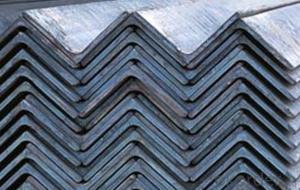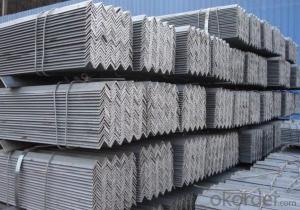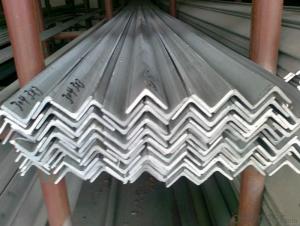High grade hot rolled equilateral angle steel
- Loading Port:
- Tianjin
- Payment Terms:
- TT OR LC
- Min Order Qty:
- 100 m.t.
- Supply Capability:
- 10000 m.t./month
OKorder Service Pledge
OKorder Financial Service
You Might Also Like
Angle called angle, strip steel is perpendicular to each other on both sides into angular.There are equilateral angle steel and unequal angle of. Equilateral angle steel two edge widthequal. The specification is expressed by edge width x edge width * thick edge millimeternumber. Such as "front 30 x 30 x 3", namely said equilateral angle steel edge width of 30 mm,3 mm thick edge. Also available models represent models is the edge width, number of centimeters, such as angle 3#. Models of the same model that in the different edge thickness and size, and thus in the contract documents general boundary angle width, edge thick size fill in complete, avoid use alone model said. Hot rolled equilateral angle steel specifications for 2#-20#. Angle according to the different needs of structure composed of a variety of stress components, but also can be used as a component of the connections between the.Widely used in a variety of architectural and engineering structures, such as beams, bridge,tower, lifting the transport machinery, ships, industrial furnace, reaction tower, container frame and warehouse.
Angle profile
Angle according to the different needs of structure composed of a variety of stress components, but also can be used as a component of the connections between the. Widely used
In a variety of architectural and engineering structures, such as beams, bridge, tower, lifting the transport machinery, ships, industrial furnace, reaction tower, container rack, cable channel support, power piping, bus mounting bracket, and warehouse shelves.
Angle is built with carbon structural steel, is a simple section steel steel, mainly used for metalcomponents and the frame of the plant. In use requires a good weldability, plastic deformation and certain mechanical strength. The production of raw materials for low carbon steel billetsteel billets, finished angle for the hot rolling, normalizing or hot-rolled state of delivery.
Type specification
Mainly divided into equilateral angle steel and equilateral angle steel two categories, includingunequal angle can be divided into equilateral equilateral thick and unequal thickness two.
Angle specifications expressed with side length and edge thickness size. At present domesticsteel specifications for 2 - 20 cm in length, number number, the same horn steel often have 2- 7 different edge thickness. The actual size and edge inlet angle marked on both sides of thethickness and indicate the relevant standards. The general length of more than 312.5px for large angle, 312.5px - 125px for the medium angle, length below 125px for small angle.
Inlet and outlet angle steel orders generally required the use specifications in the main, thesteel is carbon steel grades corresponding. Is the angle in addition to standard number, nospecific composition and performance series. Angle iron delivery length is divided into fixed length, double length two, domestic angle of fixed length of choice scope has 3 9m, 4 12M, 419m, 6 19m four scope according to the specifications of different. Japanese angle length selection range is 6 - 15m.
Section unequal angle height according to the long edge of the width to calculate the scalene angle steel. Refer to section for angular and both sides unequal in length of steel. Is an angleof. Its length from 25mm * 16mm to 200mm * l25mm. From the hot rolling mill and rolling.General specifications for: scalene angle steel angle 50*32-- angle 200*125 thickness of 4-18mm
Unequal angle steel is widely used in all kinds of metal structures, bridges, machinery manufacturing and shipbuilding, building structure and engineering structures, such as beams, bridges, power transmission tower, lifting the transport machinery, ships, industrial furnace, reaction tower, container frame and warehouse etc..
Import and export
China's import and export have a certain angle each batch, mainly imported from Japan andWestern europe. Exports to Hong Kong and Macao, Southeast Asia, the area is mainly on Latin America and Arabia countries etc.. Export production enterprises mainly in Liaoning,Hebei, Beijing, Shanghai, Tianjin and other provinces and cities of iron and steel plant (rolling mill).
Angle for the large variety of imports, small angle and special shape angle, export varieties for the medium angle such as 6, 7, etc..
- Q:What is the maximum allowable tensile stress for a steel angle?
- The maximum tensile stress that a steel angle can withstand depends on several factors, including the grade of steel, the manufacturing process, and the intended use. Steel angles are commonly used in construction and structural applications, and their maximum tensile stress is typically determined by industry standards and design codes. For instance, in the United States, the American Institute of Steel Construction (AISC) provides design specifications for structural steel angles. According to AISC, the maximum tensile stress for a steel angle is typically based on its yield strength. Yield strength refers to the stress at which a material permanently deforms. It is usually specified in pounds per square inch (psi) or megapascals (MPa). Steel angles are generally designed to operate within a certain percentage of their yield strength to ensure safety and structural integrity. In general, the maximum tensile stress for a steel angle is often restricted to a percentage of its yield strength, typically ranging from 50% to 70%. This means that the maximum stress that can be applied to a steel angle is a fraction of its yield strength. To determine the specific maximum tensile stress for a particular steel angle in a specific application, it is important to consult the appropriate design standards and codes, such as those provided by AISC or other relevant organizations. These standards take into account factors like load conditions, safety factors, and environmental conditions to guarantee the reliability and structural integrity of the steel angle.
- Q:How are steel angles used in structural framing?
- Steel angles are commonly used in structural framing as they provide stability and support. They are often used to reinforce corners and joints, adding strength to the overall structure. Steel angles are also used as braces and supports in various construction projects, helping to distribute weight and prevent sagging or collapsing.
- Q:Can steel angles be used in electrical or telecommunications installations?
- Yes, steel angles can be used in electrical or telecommunications installations. Steel angles are commonly used as structural supports and mounting brackets in these types of installations due to their strength, durability, and versatility.
- Q:Are steel angles corrosion-resistant?
- Depending on the steel used and the presence of protective coatings, steel angles may or may not be corrosion-resistant. Stainless steel angles, for instance, possess a high resistance to corrosion thanks to their significant chromium content. This particular alloy creates a protective layer on the surface that prevents corrosion. In contrast, galvanized steel angles are covered with a zinc layer that offers excellent protection against corrosion. On the other hand, untreated carbon steel angles are not resistant to corrosion and will rust if exposed to moisture or corrosive environments. Therefore, it is crucial to take into account the specific type of steel and any additional protective measures when assessing the corrosion resistance of steel angles.
- Q:Can steel angles be used in marine or underwater applications?
- Yes, steel angles can be used in marine or underwater applications. Steel angles are often used in construction and engineering projects due to their high strength and durability. In marine or underwater environments, where corrosion and water exposure are common, steel angles can be coated or treated to enhance their resistance to rust and degradation. Additionally, their structural properties make them suitable for various applications such as shipbuilding, offshore platforms, or underwater pipelines.
- Q:Can steel angles be used for building frames?
- Yes, steel angles can be used for building frames. Steel angles are commonly used in construction for framing applications due to their strength and versatility. They are often used to create the structural framework of buildings, such as in the construction of walls, floors, and roofs. Steel angles provide stability and support to the overall structure and can be easily welded or bolted together to create a strong and durable frame. Additionally, steel angles are available in various sizes and thicknesses, allowing for customization and adaptation to different building requirements. Overall, steel angles are a popular choice for building frames due to their strength, versatility, and ease of use.
- Q:How do steel angles contribute to the energy efficiency of a building?
- Steel angles can contribute to the energy efficiency of a building in several ways. Firstly, steel angles are commonly used as structural elements in the construction of buildings. They provide strength and support to the building's framework, allowing for the use of larger windows and open floor plans. This promotes natural daylighting and reduces the need for artificial lighting during the day, thereby reducing energy consumption. Additionally, steel angles can be used to create energy-efficient building envelopes. By incorporating steel angles into the construction of walls, roofs, and floors, thermal bridging can be minimized. Thermal bridging occurs when materials with high thermal conductivity, such as concrete or wood, allow heat to escape or enter the building, leading to increased energy consumption for heating or cooling. Steel, on the other hand, has a low thermal conductivity, which helps to reduce heat transfer and improve the overall thermal performance of the building envelope. Moreover, steel angles can be used in the installation of energy-saving systems and equipment. For instance, they can be used to support solar panels, which generate clean and renewable energy. Steel angles can also be utilized in the installation of HVAC systems, allowing for efficient air circulation and distribution throughout the building. By using steel angles in these applications, the energy efficiency of the building can be enhanced, leading to reduced energy consumption and lower utility bills. In conclusion, steel angles play a significant role in promoting energy efficiency in buildings. They contribute to the structural integrity of the building, help minimize thermal bridging, and can support the installation of energy-saving systems. By incorporating steel angles into the design and construction of a building, energy consumption can be reduced, resulting in a more sustainable and cost-effective built environment.
- Q:Are steel angles suitable for coastal or saltwater environments?
- Yes, steel angles can be suitable for coastal or saltwater environments. However, it is important to consider the type of steel used and the proper protective measures taken to ensure durability and resistance to corrosion. Stainless steel angles, particularly those made from marine grade stainless steel (such as 316 or 316L), are known for their excellent resistance to corrosion in saltwater environments. These stainless steel angles have a higher content of chromium and molybdenum, which provides enhanced protection against rust and corrosion caused by exposure to saltwater and other harsh elements. Furthermore, additional protective coatings or treatments such as galvanization or epoxy coating can be applied to steel angles to further enhance their resistance to corrosion in coastal or saltwater environments. These coatings create a barrier between the steel and the corrosive elements, preventing direct contact and reducing the risk of rust or corrosion. It is crucial to consult with structural engineers, architects, or steel suppliers who specialize in coastal or saltwater applications to determine the most suitable type of steel and protective measures for the specific project. Proper maintenance and regular inspections are also important to identify any signs of corrosion or damage and address them promptly to ensure the longevity and safety of the steel angles in coastal or saltwater environments.
- Q:Can steel angles be used for manufacturing furniture?
- Yes, steel angles can be used for manufacturing furniture. Steel angles are versatile and durable, making them suitable for various applications including furniture manufacturing. They can be used to create strong and sturdy frames, legs, and supports for different types of furniture such as tables, chairs, shelves, and cabinets. Steel angles are known for their strength and structural integrity, making them an excellent choice for furniture that needs to withstand heavy loads or have a long lifespan. Additionally, steel angles can be easily welded, cut, and shaped to fit specific design requirements, allowing for customization and creativity in furniture manufacturing.
- Q:What are the different shapes available for steel angles?
- Steel angles come in various shapes, each serving a specific purpose in construction and structural applications. The most common shapes include the following: 1. Equal angles: These angles have legs of equal length and are formed by bending a single piece of steel. They find common use in general structural applications, such as supporting beams and columns. 2. Unequal angles: As the name suggests, these angles have legs of unequal length. They are often employed when one leg needs to be longer or shorter than the other. In construction, they provide additional strength and support in various applications. 3. L-shaped angles: These angles have one leg longer than the other, creating an L-shape. They are frequently used to reinforce corners and edges of structures, offering extra strength and support. 4. T-shaped angles: These angles have a longer leg that extends perpendicular to a shorter leg, forming a T-shape. They are commonly utilized as lintels or beams to support loads above openings like doors and windows. 5. C-shaped angles: These angles have one side curved inward, resulting in a C-shape. They are often employed in situations where the angle needs to fit around a curved or rounded surface, providing structural support and reinforcement. In summary, the availability of various steel angle shapes enables a wide range of applications in construction and structural engineering. They offer strength, support, and versatility in numerous projects.
1. Manufacturer Overview |
|
|---|---|
| Location | |
| Year Established | |
| Annual Output Value | |
| Main Markets | |
| Company Certifications | |
2. Manufacturer Certificates |
|
|---|---|
| a) Certification Name | |
| Range | |
| Reference | |
| Validity Period | |
3. Manufacturer Capability |
|
|---|---|
| a)Trade Capacity | |
| Nearest Port | |
| Export Percentage | |
| No.of Employees in Trade Department | |
| Language Spoken: | |
| b)Factory Information | |
| Factory Size: | |
| No. of Production Lines | |
| Contract Manufacturing | |
| Product Price Range | |
Send your message to us
High grade hot rolled equilateral angle steel
- Loading Port:
- Tianjin
- Payment Terms:
- TT OR LC
- Min Order Qty:
- 100 m.t.
- Supply Capability:
- 10000 m.t./month
OKorder Service Pledge
OKorder Financial Service
Similar products
New products
Hot products
Related keywords




























